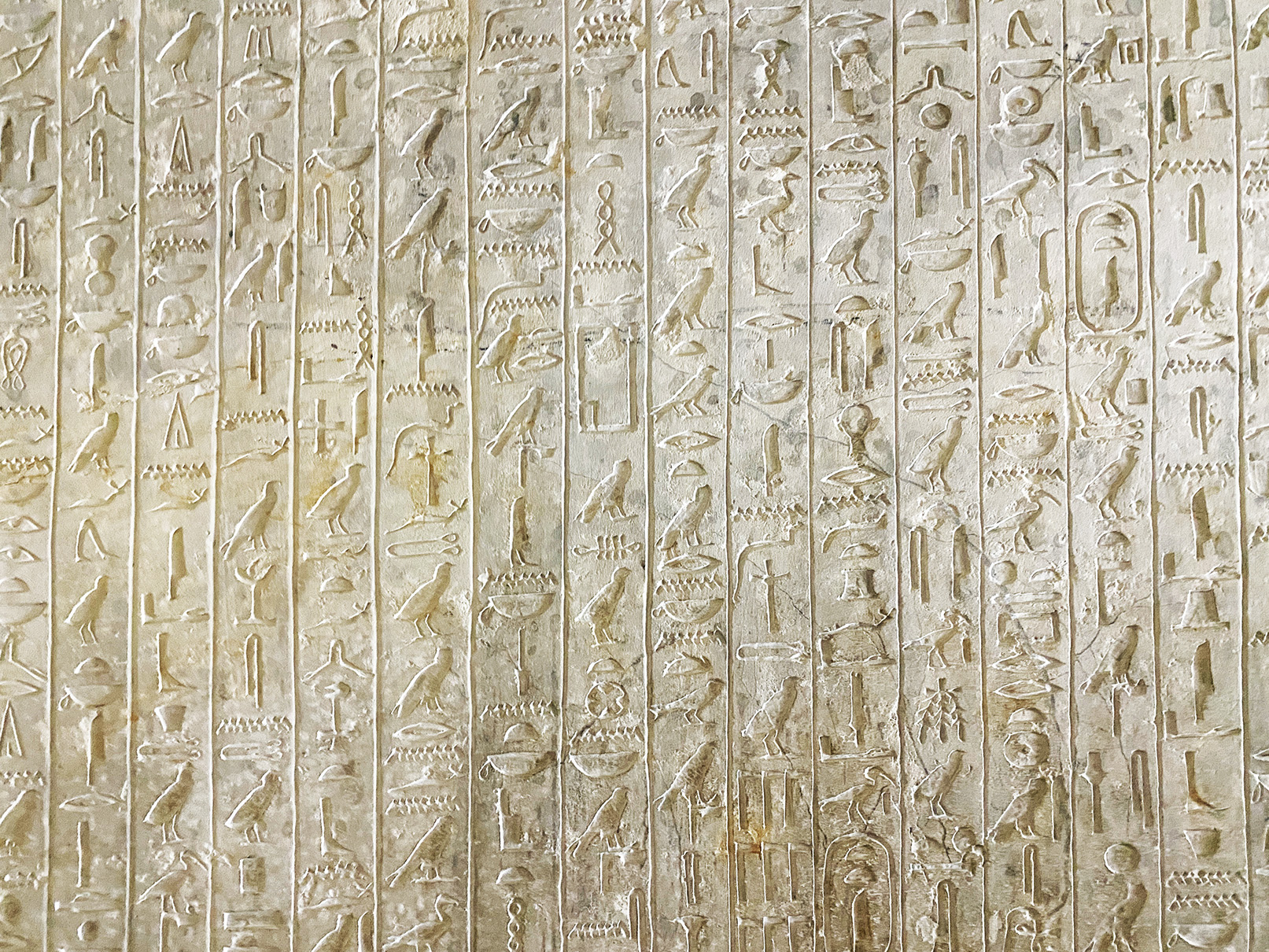Pyramid Texts
The Pyramid Texts are the oldest ancient Egyptian funerary texts, dating to the late Old Kingdom. They are the earliest known corpus of ancient Egyptian religious texts. Written in Old Egyptian, the pyramid texts were carved onto the subterranean walls and sarcophagi of pyramids at Saqqara from the end of the Fifth Dynasty, and throughout the Sixth Dynasty of the Old Kingdom, and into the Eighth Dynasty of the First Intermediate Period.
The oldest of the texts have been dated to c. 2400–2300 BC. Unlike the later Coffin Texts and Book of the Dead, the Pyramid Texts were not illustrated.
The use and occurrence of Pyramid Texts changed between the Old, Middle, and New Kingdoms of Ancient Egypt. During the Old Kingdom (2686 BCE – 2181 BCE), Pyramid Texts could be found in the pyramids of kings as well as three queens, named Wedjebten, Neith, and Iput.
Discovery and publication
French archaeologist and Egyptologist Gaston Maspero, director of the French Institute for Oriental Archaeology in Cairo, arrived in Egypt in 1880. He chose a site in South Saqqara, a hill that had been mapped by the Prussian Egyptologist Karl Richard Lepsius in 1842, for his first archaeological dig. There, Maspero found the ruins of a large structure, which he concluded must be the pyramid of Pepi I of the Sixth Dynasty. During the excavations he was able to gain access to the subterranean rooms, and discovered that the walls of the structure were covered in hieroglyphic text.
Maspero continued his excavations at a second structure, around one kilometer south-west of the first, in search of more evidence. This second structure was determined to be the pyramid of Merenre I, Pepi I's successor. In it, Maspero discovered the same hieroglyphic text on the walls he'd found in Pepi I's pyramid, and the mummy of a man in the sarcophagus of the burial chamber. This time, he visited Mariette personally, who again rejected the findings, saying on his deathbed that "[i]n thirty years of Egyptian excavations I have never seen a pyramid whose underground rooms had hieroglyphs written on their walls." Throughout 1881, Maspero continued to direct investigations of other sites in Saqqara, and more texts were found in each of the pyramids of Unas, Teti and Pepi II. Maspero began publishing his findings in the Recueil des Travaux from 1882 and continued to be involved until 1886 in the excavations of the pyramid in which the texts had been found.
Maspero published the first corpora of the text in 1894 in French under the title Les inscriptions des pyramides de Saqqarah. Translations were made by German Egyptologist Kurt Heinrich Sethe to German in 1908–1910 in Die altägyptischen Pyramidentexte. The concordance that Sethe published is considered to be the standard version of the texts. Samuel A. B. Mercer published a translation into English of Sethe's work in 1952. British Egyptologist Raymond O. Faulkner presented the texts in English in 1969 in The Ancient Egyptian Pyramid Texts.
Purpose
The spells, or utterances, of the Pyramid Texts were primarily concerned with enabling the transition of the deceased from a human mortal to an immortal star in the sky, joining the Egyptian decans. The spells of the Pyramid Texts are divided into two broad categories: Sacerdotal texts and Personal texts.
The sacerdotal texts are ritual in nature, and were conducted by the lector priest addressing the deceased in the second person. They consist of offering spells, short spells recited in the presentation of an offering, and recitations which are predominantly instructional. These texts appear in the Offering and Insignia Rituals, the Resurrection Ritual, and in the four pyramids containing the Morning Ritual. The writing in these texts (Dramatic Texts) suggests the formulation of these texts may have occurred around the time of the Second and Third dynasties.
The remaining texts are personal, and are broadly concerned with guiding the spirit out of the tomb, and into new life. They consist of provisioning, transition, and apotropaic – or protective – texts. The provisioning texts deal with the deceased taking command of his own food-supply, and demanding nourishment from the gods. One example of these texts is the king's response in Unas' pyramid. These texts form the largest part of the corpus, and are dominated by the youngest texts composed in the Fifth and possibly Sixth dynasties. Apotropaic texts consist of short protective spells for warding off threats to the body and tomb. Due to the archaic style of writing, these texts are considered to be the oldest, and are the most difficult to interpret.
